1997 OLDSMOBILE BRAVADA fuel
[x] Cancel search: fuelPage 223 of 358

Adding Equipment to the Outside of
Your Oldsmobile
Things you might add to the outside of your vehicle can
affect the airflow around
it. This may cause wind noise
and affect windshield washer performance. Check with
your Oldsmobile retailer before adding equipment to the outside of your vehicle.
Fuel
Use regular unleaded gasoline rated at 87 octane or
higher. At a minimum, it should meet specifications
ASTM D4814 in the United States and CGSB 3.5-M93
in Canada. Improved gasoline specifications have been developed by the American Automobile Manufacturers
Association
(MA) for better vehicle performance
and engine protection. Gasolines meeting the AAMA
specification could provide improved driveability and
emission control system protection compared to
other gasolines.
Be sure the posted octane is at least
87. If the octane is
less than 87, you may get a heavy knocking noise when
you drive.
If it’s bad enough, it can damage your engine.
If you’re using fuel rated at 87 octane or higher and you
still hear heavy knocking, your engine needs service.
But don’t worry if you hear a little pinging noise when
you’re accelerating or driving up a hill. That’s normal,
and you don’t have to buy a higher octane fuel to get rid
of pinging. It’s the heavy, constant knock that means
you have a problem.
If your vehicle is certified to meet California Emission
Standards (indicated on the underhood tune-up label), it
is designed to operate on fuels that meet California
specifications. If such fuels are not available in states
adopting California emissions standards, your vehicle
will operate satisfactorily on fuels meeting federal
specifications, but emission control system performance
may be affected. The malfunction indicator lamp on
your instrument panel may
turn on and/or your vehicle
may fail a smog-check test. If this occurs, return to your
authorized Oldsmobile retailer for diagnosis to
determine the cause of failure. In the event it is
determined that the cause of the condition is the type of
fuels used, repairs may not be covered by your warranty.
ProCarManuals.com
Page 224 of 358

Some gasolines that are not reformulated for low
emissions contain an octane-enhancing additive called
methylcyclopentadlenyl manganese tricarbonyl
(MMT);
ask your service station operator whether or not his fuel
contains MMT. General Motors does not recommend the
use of such gasolines.
If fuels containing MMT are used,
spark plug life may be reduced and your emission
control system performance may be affected. The
malfunction indicator lamp on your instrument panel
may turn on. If this occurs, return to your authorized
Oldsmobile retailer for service.
To provide cleaner air, all gasolines
in the United States
are now required to contain additives that will help
prevent deposits from forming in your engine and
fuel
system, allowing your emission control system to
function properly. Therefore, you should not have to add
anything to the fuel.
In addition, gasolines containing
oxygenates, such
as ethers and ethanol, and
reformulated gasolines may be available in your area
to
help clean the air. General Motors recommends that you
use these gasolines if they comply with the
specifications described earlier.
NOTICE:
Your vehicle was not designed for fuel that
contains methanol. Don’t use it. It can corrode
metal parts in your fuel system and also damage
plastic and rubber parts. That damage wouldn’t
be covered under your warranty.
~~
Fuels in Foreign Countries
If you plan on driving in another country outside the United
States or Canada, the proper fuel may be hard to find. Never
use leaded gasoline or any other
fuel not recommended in the
previous text
on fuel. Costly repairs caused by use of
improper fuel wouldn’t be covered by your warranty.
To check on fuel availability, ask an auto club, or
contact
a major oil company that does business in the
country where you’ll be driving.
You can also write us at the following address for
advice. Just tell
us where you’re going and give your
Vehicle Identification Number
(VIN).
General Motors Overseas Distribution Corporation,
North American Export Sales (NAES)
1908 Colonel Sam Drive
Oshawa, Ontario L1H 8P7
6-4
ProCarManuals.com
Page 225 of 358
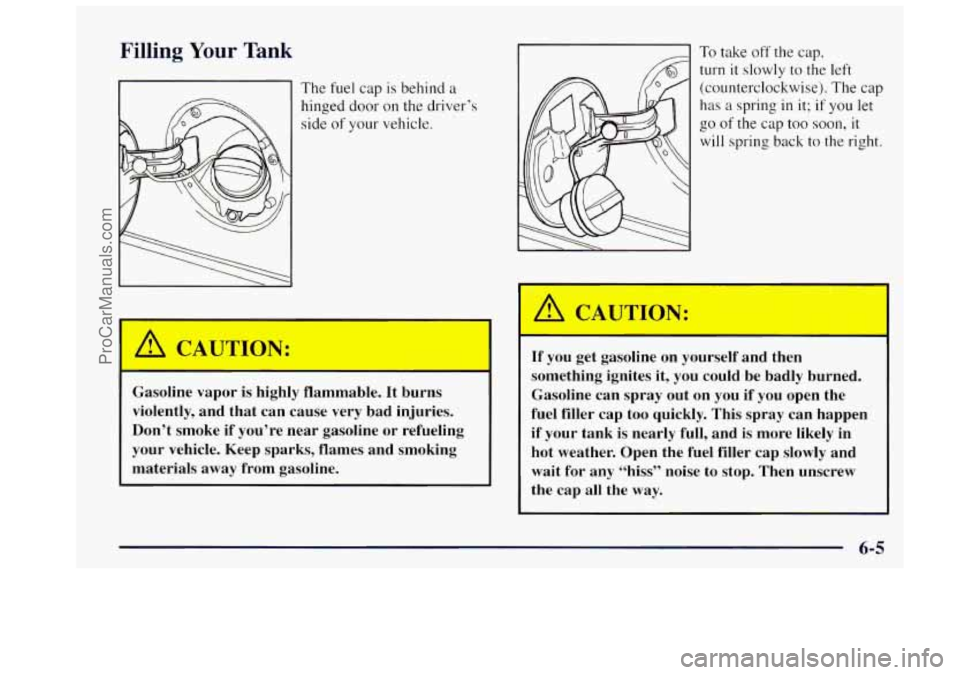
Filling Your Tank
The fuel cap is behind a
hinged door
on the driver’s
side
of your vehicle.
’
I A CAUTION: I
Gasoline vapor is highly flammable. It burns
violently, and that can cause very bad injuries.
Don’t smoke
if you’re near gasoline or refueling
your vehicle. Keep sparks, flames and smoking
materials away from gasoline.
To take off the cap,
turn
it slowly to the left
(counterclockwise). The cap
has a spring in it; if you let
go of the cap too soon, it
will
spring back to the right.
I A CAUTION:
If you get gasoline on yourself and then
something ignites it, you could be badly burned.
Gasoline can spray out on you if you open the
fuel filler cap too quickly. This spray can happen
if your tank is nearly full, and is more likely in
hot weather. Open the fuel filler cap slowly and
wait for any “hiss” noise to stop. Then unscrew
the cap
all the way.
ProCarManuals.com
Page 226 of 358
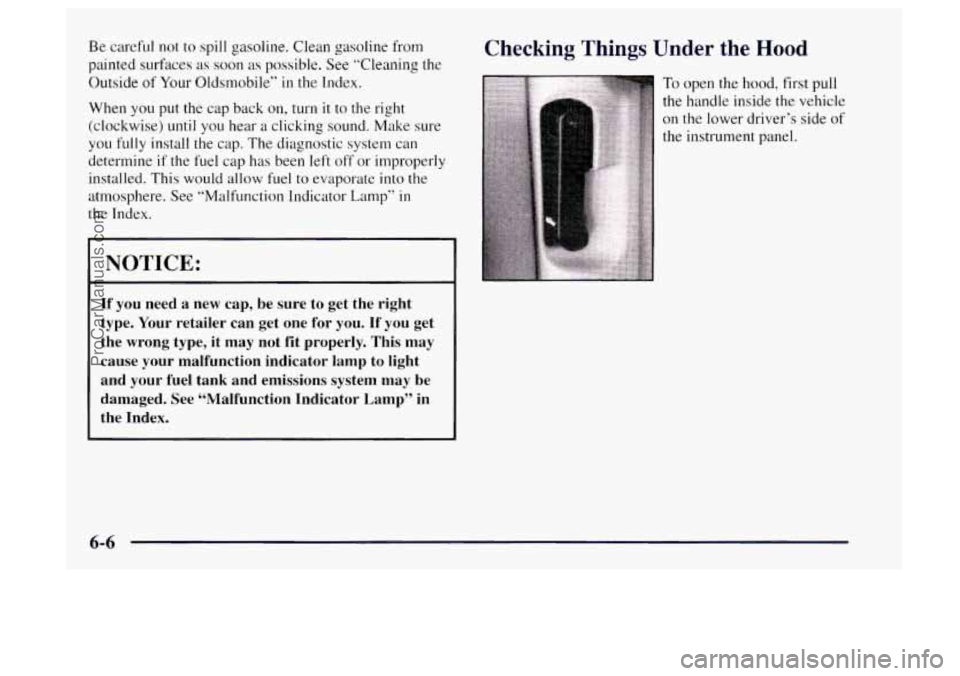
Be careful not to spill gasoline, Clean gasoline from
painted surfaces as soon
as possible. See “Cleaning the
Outside
of Your Oldsmobile” in the Index.
When you put
the cap back on, turn it to the right
(clockwise) until
you hear a clicking sound. Make sure
you fully install the cap. The diagnostic system can
determine
if the fuel cap has been left off or improperly
installed.
This would allow fuel to evaporate into the
atmosphere. See “Malfunction Indicator Lamp” in
the Index.
I I
I NOTICE:
If you need a new cap, be sure to get the right
type. Your retailer can get one for you.
If you get
the wrong type, it may not fit properly. This may
cause your malfunction indicator lamp to light and your fuel tank and emissions system may be
damaged. See “Malfunction Indicator Lamp’’ in
the Index.
Checking Things Under the Hood
To open the hood, first pull
the handle inside the vehicle
on the lower driver’s side
of
the instrument panel.
6-6
ProCarManuals.com
Page 229 of 358

*--
Before closing the hood, be sure all the filler caps are on Checking Engine Oil
properly. Then lift the hood to relieve pressure on the
hood prop.
Remove the hood prop from the slot
in the hood and keeping the tip down, and check the level.
return the prop to its retainer. Pull
out the dipstick and clean it with a paper towel or
’ , . . cloth, then push it back in all the way. Remove it again,
--
Then just pull the hood down firmly to close. It will
latch when dropped from
10 to12 inches (25 to 30 cm)
without pressing on the hood.
Engine Oil
It’s a good idea to check your engine oil every time you
get fuel.
In order to get an accurate reading, the oil must
be warm and the vehicle must be
on level ground.
The oil dipstick is a
yellow ring.
Turn off the engine and give
the
oil a few minutes to
drain back into the oil pan.
If you don’t, the oil dipstick
might not show the
actual level.
6-9
ProCarManuals.com
Page 231 of 358
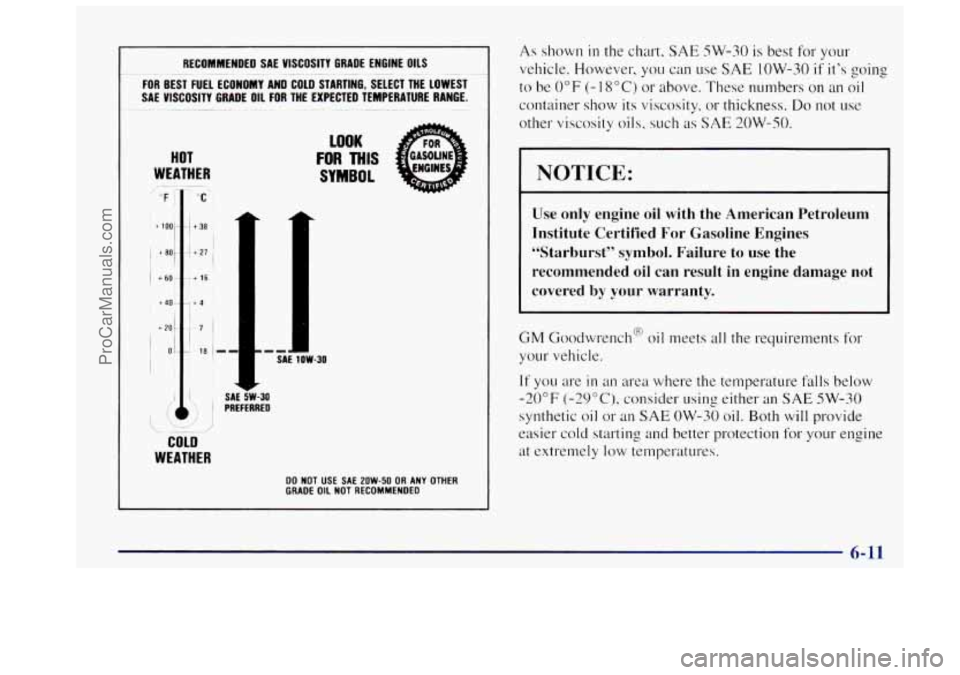
I 1
RECOMMENDED SAE VISCOSITY GRADE ENGINE OILS
FOR BEST FUEL ECONOMY AND COLD STARTING, SELECT THE LOWEST
SAE VISCOSITY GRADE OIL
FOR THE EXPECTED TEMPERATURE RANGE.
~- - -. ~ -. . ~ .- . ~ .~ ~.. ~- ..
HOT
WEATHER , . . . .. .-
"F -I x
LOOK
FOR MIS
SYMBOL
-30
00 NOT USE SAE 2DW-50 OR ANY OTHER GRADE OIL NOT RECOMMENDED
As shown in the chart. SAE SW-30 is best for your
vehicle. However, you can use
SAE 1OW-30 if it's going
to be
0" F (- 1 8 " C) or above. These numbers on an oil
container show its viscosity, or thickness. Do not LIS(;:
other viscosity oils, such as SAE 20W-SO.
I NOTICE:
Use only engine oil with the American Petroleum
Institute Certif'ied For Gasoline Engines
"Starburst" symbol. Failure to use the
recommended oil can result in engine damage not
covered
by your warranty.
GM Goodwrench@ oil meets all the requirements for
your vehicle.
If you are in a11 area where the temperature fills below
-20°F (-29°C). consider using either an SAE SW-30
synthetic oil or an SAE OW-30 oil. Both will provide
easier cold starting and better protection for engine
at extremely
low temperatures.
6-11
ProCarManuals.com
Page 257 of 358
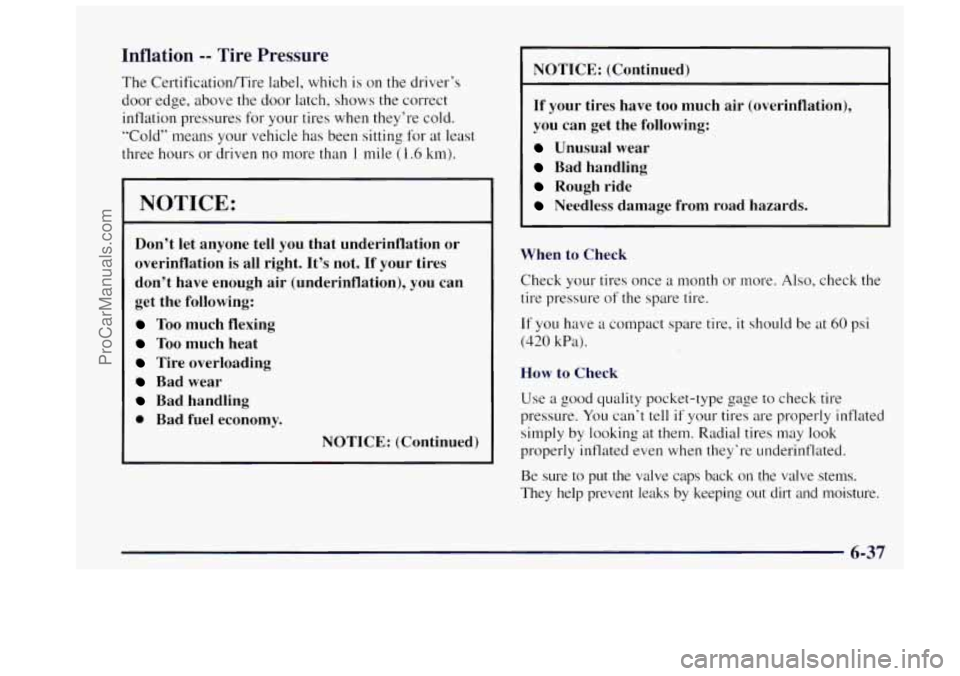
Inflation -- Tire Pressure
The Certificationmire label, which is on the driver’s
door edge, above the door latch, shows the correct
inflation pressures for your tires when they’re cold.
“Cold” means your vehicle has been sitting for at least
three hours or driven no more than
1 mile (1.6 km).
NOTICE:
Don’t let anyone tell you that underinflation or
overinflation is all right. It’s not.
If your tires
don’t have enough
air (underinflation), you can
get the following:
Too much flexing
Too much heat
Tire overloading
Bad wear
Bad handling
0 Bad fuel economy.
NOTICE: (Continued)
I I
NOTICE: (Continued)
i If your tires have too much air (overinflation),
you can get the following:
Unusual wear
Bad handling
Rough ride
Needless damage from road hazards.
When to Check
Check your tires once
a month or more. Also, check the
tire pressure
of the spare tire.
If you have a compact spare tire, it should be at 60 psi
(420 kPa).
How
to Check
Use a
good quality pocket-type gage to check tire
pressure.
You can’t tell if your tires are properly inflated
simply by looking
at them. Radial tires may look
properly inflated even when they‘re underinflated.
Be sure
to put the valve caps back on the valve stems.
They help prevent leaks by keeping out dirt and moisture.
6-37
ProCarManuals.com
Page 271 of 358
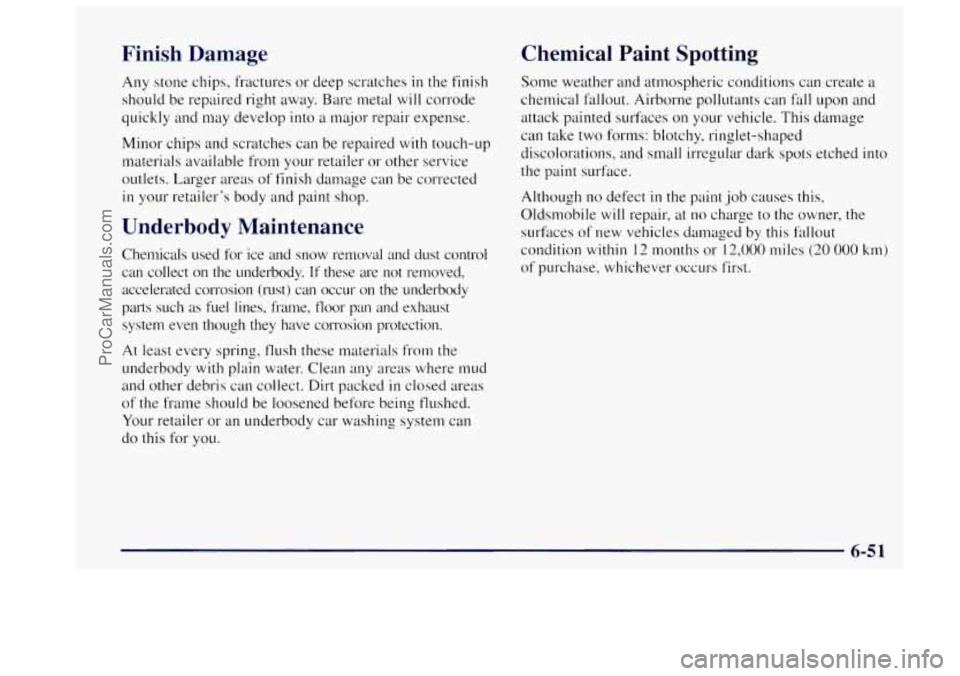
Finish Damage
Any stone chips, fractures or deep scratches in the finish
should be repaired right away. Bare metal will corrode
quickly and may develop
into a major repair expense.
Minor chips and scratches can be repaired with touch-up
materials available from
your retailer or other service
outlets. Larger areas of finish damage can be corrected
in your retailer’s body and paint shop.
Underbody Maintenance
Chemicals used for ice and snow removal and dust control
can collect on the underbody. If these are not removed,
accelemted corrosion (rust) can occur on the underbody
parts such as fuel lines, frame,
floor pan and exhaust
system even though they have corrosion protection.
At least every spring, flush these materials from the
underbody
with plain water. Clean any areas where mud
and other debris can collect. Dirt packed
in closed areas
of the frame should be loosened before being, flushed.
Your retailer
or an underbody car washing system can
do this for you.
Chemical Paint Spotting
Some weather and atmospheric conditions can create a
chemical fallout. Airborne pollutants can
fall upon and
attack painted surfaces on your vehicle. This damage
can take two forms: blotchy, ringlet-shaped
discolorations, and small irregular dark spots etched into
the paint surface.
Although no de.fect
in the paint job causes this,
Oldsmobile
will repair, at no charge to the owner, the
surfaces
of new vehicles damaged by this fallout
condition
within 12 months or 12,000 miles (20 000 km)
of purchase, whichever occurs first.
6-51
-
ProCarManuals.com